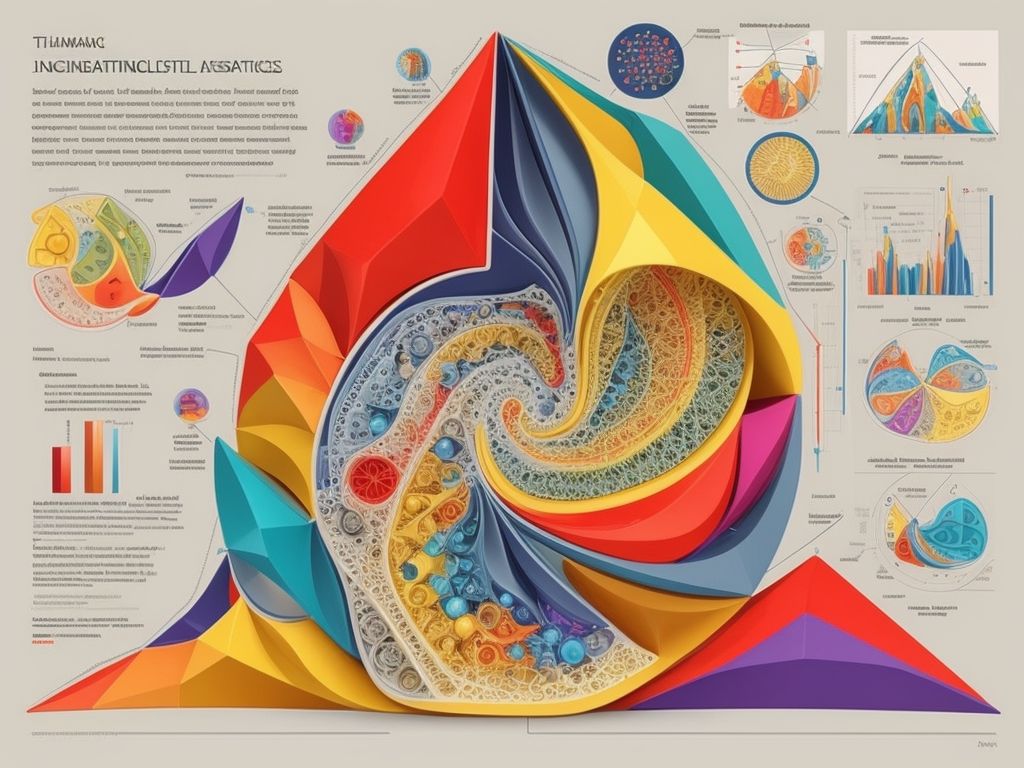How to Design an Elementary Statistics Guide
Designing an elementary statistics guide is a crucial task in providing students with a solid foundation in this essential branch of mathematics. Statistics plays a significant role in various fields, including science, economics, and social sciences. Understanding elementary statistics is not just about calculations and formulas; it is about equipping students with the skills to analyze data, make informed decisions, and critically evaluate information.
Elementary statistics provides students with the tools to interpret and summarize data, understand probability and uncertainty, and draw meaningful conclusions. It is relevant in everyday life, helping individuals make informed decisions based on data analysis and understand statistical information presented in various forms such as surveys, polls, and research studies.
Learning elementary statistics offers several benefits. It improves critical thinking and problem-solving skills, enhances data literacy, and enables students to make evidence-based decisions. It also equips students with the ability to critically analyze information and arguments presented in the media, promoting data-driven decision-making.
To design an effective elementary statistics guide, several steps need to be taken. These include defining the scope and objectives, identifying the target audience, planning the content structure, deciding on the presentation style, and selecting appropriate examples and exercises to reinforce understanding.
Key topics that should be included in an elementary statistics guide are descriptive statistics, probability, sampling and sampling distributions, inferential statistics, hypothesis testing, and regression and correlation analysis. These topics cover the fundamental concepts and techniques needed to comprehend and analyze data effectively.
Choosing the right resources and tools is crucial in the development of an elementary statistics guide. Recommended textbooks and online resources can provide additional explanations, practice problems, and real-world applications. The use of software and calculators designed for elementary statistics can enhance the learning experience and facilitate data analysis.
To ensure effective teaching of elementary statistics, engaging activities and examples should be incorporated into the guide. Visual aids and demonstrations can help students grasp abstract concepts and make connections to real-world scenarios. Interactive learning methods, such as group discussions and hands-on activities, can promote active participation and deeper understanding.
By following these principles and incorporating these elements into the design, an elementary statistics guide can be created to help students develop a strong foundation in this essential subject and apply statistical concepts in various contexts.
Key takeaways:
- Determine scope and objectives: Before designing an elementary statistics guide, it is important to clearly define the scope and objectives of the guide to ensure it meets the needs of the learners.
- Identify the target audience: Understanding the target audience of the guide is crucial in order to tailor the content and examples to their specific needs and learning styles.
- Select appropriate examples and exercises: Including relevant and varied examples and exercises in the guide will help reinforce key concepts and engage learners in active learning.
The Importance of Teaching Elementary Statistics
Teaching elementary statistics plays a crucial role as it emphasizes the importance of understanding statistical concepts. By providing students with essential analytical skills, it equips them with the necessary tools for success in various fields. This knowledge allows students to make informed decisions, accurately interpret data, and effectively solve real-world problems. Moreover, teaching elementary statistics fosters critical thinking, logical reasoning, and improves quantitative literacy. Given the increasing demand for data analysis in today’s world, it empowers students to be informed consumers, responsible citizens, and future professionals who can contribute meaningfully to society.
Here’s a true story illustrating the importance of teaching elementary statistics: Sarah, a high school student, used to struggle with math. However, everything changed when she enrolled in a statistics class. Through the use of real-life examples and engaging hands-on activities, she discovered the practicality of statistics. This newfound understanding not only boosted her confidence in math but also helped her excel in other subjects. Sarah developed critical thinking skills and became a data-savvy individual equipped to navigate the complexities of the modern world. This transformation can be attributed to the significant role played by teaching elementary statistics.
Why is Elementary Statistics Relevant?
Elementary statistics is relevant for several reasons. Why is Elementary Statistics Relevant? It provides a foundation for analyzing and interpreting data, which is important in various fields, such as business, economics, and research. Understanding elementary statistics helps individuals make informed decisions based on data-driven evidence. It also enables individuals to critically evaluate and understand statistical information presented in everyday life, such as news articles or research studies. Elementary statistics equips individuals with the skills to conduct basic research and contribute to the advancement of knowledge in their respective fields. Elementary statistics is relevant because it empowers individuals to navigate and thrive in a data-driven world. Why is Elementary Statistics Relevant?
The Benefits of Learning Elementary Statistics
The Benefits of Learning Elementary Statistics
Learning elementary statistics provides numerous benefits that can be applied in various aspects of life. These benefits include:
- Enhanced decision-making: Understanding statistics enables individuals to analyze data and make informed decisions based on evidence.
- Improved critical thinking: Learning statistical concepts sharpens analytical skills, helping individuals evaluate information and draw logical conclusions.
- Effective problem-solving: Statistics equips individuals with problem-solving techniques, allowing them to identify patterns, draw associations, and find solutions.
- Enhanced research skills: Elementary statistics teaches individuals how to design studies, collect data, and interpret the results, which are invaluable skills in academic and professional research.
- Improved data literacy: Learning statistics helps individuals navigate and interpret data-driven information in various fields, from economics to healthcare.
- Expanded career opportunities: Strong statistical skills are sought after in fields such as data analysis, market research, finance, and social sciences, opening up diverse career prospects.
Understanding the Basics of Elementary Statistics
Get ready to dive into the fascinating world of elementary statistics! In this section, we will unravel the mysteries behind this essential branch of mathematics. We will unravel the key concepts that form the foundation of elementary statistics, and explore common statistical terms that you’ll encounter throughout your statistical journey. So, buckle up and prepare to equip yourself with the knowledge needed to conquer the world of numbers and data!
Key Concepts in Elementary Statistics
In elementary statistics, key concepts in Elementary Statistics form the foundation of understanding and analyzing data. These concepts, such as measures of central tendency (mean, median, mode), measures of variability (range, standard deviation), probability, hypothesis testing, sampling methods, and correlation, are essential for making informed interpretations and decisions based on data. By grasping these essential Key Concepts in Elementary Statistics, students can develop valuable analytical skills that are applicable in various fields such as business, research, and healthcare. Mastery of these concepts enables individuals to effectively navigate and interpret data, making them informed consumers and decision-makers in today’s data-driven world.
In the late 18th century, Carl Friedrich Gauss introduced the concept of the normal distribution, also known as the Gaussian distribution or bell curve, which played a significant role in shaping the field of elementary statistics. Gauss’s work paved the way for further advancements in probability theory and statistical analysis, revolutionizing the way data is understood and interpreted. His contributions to the field continue to be relevant and influential, highlighting the timeless importance of Key Concepts in Elementary Statistics.
Common Statistical Terms
| Common Statistical Terms | |
| Term | Definition |
| Mean | The average value of a dataset, calculated by summing all values and dividing by the total number of values. |
| Median | The middle value in an ordered dataset, separating the upper and lower halves. |
| Mode | The most frequently occurring value in a dataset. |
| Standard Deviation | A measure of how spread out the values in a dataset are from the mean. |
| Probability | The likelihood of a specific event happening, measured on a scale from 0 to 1. |
| Sampling | The process of selecting a subset of individuals or items from a larger population for analysis. |
| Regression | A statistical method used to model the relationship between variables and predict future outcomes. |
| Hypothesis | A proposed explanation or prediction that can be tested through statistical analysis. |
Steps in Designing an Elementary Statistics Guide
Designing an elementary statistics guide involves essential steps that ensure its effectiveness. We’ll dive into each of these steps to help you create a guide that resonates with your target audience. From determining the scope and objectives to selecting suitable examples and exercises, this section will provide you with valuable insights to craft a well-structured and engaging statistics guide. So, let’s begin our journey of designing an elementary statistics guide that fosters learning and enhances understanding.
1. Determine the Scope and Objectives
When designing an elementary statistics guide, it is crucial to determine the scope and objectives beforehand. This helps ensure that the guide is targeted towards the specific needs of the learners. To determine the scope and objectives, follow these steps:
| Step | Instructions |
| 1 | Identify the specific topics or concepts to be covered in the guide. |
| 2 | Consider the level of depth needed for each topic, based on the target audience’s prior knowledge and educational goals. |
| 3 | Set clear learning objectives for each topic, specifying the knowledge or skills that learners should acquire. |
| 4 | Align the objectives with relevant curriculum standards or educational requirements. |
| 5 | Ensure that the scope and objectives are achievable within the given timeframe or resources. |
By carefully determining the scope and objectives of the guide, educators can create a focused and effective resource for teaching elementary statistics.
2. Identify the Target Audience
Identifying the target audience is a crucial step in designing an elementary statistics guide. By truly understanding who will be using the guide, educators can tailor both the content and presentation style to specifically meet their needs. The target audience for an elementary statistics guide may include students in middle or high school, college students, or individuals seeking to improve their statistical literacy. When identifying the target audience, it is important to take into account factors such as prior knowledge, learning preferences, and goals. By doing so, the guide can provide relevant and accessible information, ultimately leading to effective learning in statistics. Effective methods for identifying the target audience include conducting surveys or interviews, analyzing demographic data, and seeking input from educators or statistical experts.
3. Plan the Content Structure
When designing an elementary statistics guide, it is essential to plan the content structure effectively in order to ensure a comprehensive and cohesive learning experience for the students. This involves organizing the information in a logical and coherent manner to facilitate learning.
Start by planning the content structure, including determining the scope and objectives of the guide.
Identify the target audience and tailor the content to their needs in the planning process.
Plan the sequence of topics and subtopics carefully to ensure a smooth flow of information.
Decide on the presentation style, whether it’s through text, visuals, or a combination, as part of the content structure planning.
Select appropriate examples and exercises to reinforce understanding in the content structure planning stage.
By carefully planning the content structure, the elementary statistics guide can provide a comprehensive and cohesive learning experience for the students.
4. Decide on the Presentation Style
Deciding on the presentation style plays a crucial role in the design of an elementary statistics guide. It determines the organization and delivery of information to the target audience. There is a variety of presentation styles to consider, each with its own advantages and suitability for different learning environments.
To aid in the decision-making process, here is a table that highlights three common presentation styles for an elementary statistics guide:
| Presentation Style | Description |
| Traditional Classroom | A lecture-based format where the instructor presents information and students take notes. This style allows for direct interaction and clarification of concepts. |
| Interactive Discussions | Encourages active participation and engagement through group discussions, problem-solving activities, and case studies. This style promotes collaboration and a deeper understanding of statistical concepts. |
| Online Learning | Utilizes digital platforms and multimedia resources to deliver content. This style offers flexibility in accessing materials and encourages self-paced learning through interactive exercises and videos. |
Each presentation style possesses unique strengths, and the decision will depend on factors such as learning objectives, available resources, and the preferences of the target audience.
Were you aware that incorporating multiple presentation styles can enhance the effectiveness of an elementary statistics guide? It caters to different learning preferences and maximizes engagement.
5. Select Appropriate Examples and Exercises
When designing an elementary statistics guide, it is crucial to select appropriate examples and exercises that effectively engage and enhance the learning experience of students. Here is a list of steps to follow:
- Identify the key concepts and skills that students should learn through selecting appropriate examples and exercises.
- Choose examples and exercises that correspond to real-life scenarios and are relatable to students’ interests and experiences.
- Vary the complexity of the examples, starting with simple ones and gradually increasing the difficulty to challenge students.
- Incorporate a mix of numerical and graphical examples to help students visualize and understand statistical concepts effectively.
- Select exercises that cover a range of difficulty levels, allowing students to practice and reinforce their understanding of the material.
- Include both conceptual questions and calculation-based exercises to assess students’ comprehension and problem-solving skills.
- Ensure that the examples and exercises align with the learning objectives and provide opportunities for students to apply statistical techniques in different contexts.
By following these steps, educators can create an engaging and effective elementary statistics guide that enables students to grasp statistical concepts and develop problem-solving abilities.
Key Topics to Include in an Elementary Statistics Guide
When designing an elementary statistics guide, it is crucial to include key topics to provide a strong foundation in statistical concepts. It is important to cover the basics of data analysis, probability, and inferential statistics in order to ensure comprehensive understanding. In addition, incorporating graphical representations, such as bar graphs, pie charts, and scatterplots, can greatly assist students in visualizing data effectively. The guide should also contain detailed explanations and relevant examples of key statistical measures, such as mean, median, and mode. Furthermore, it is essential to include different types of sampling techniques to enhance the students’ understanding and practical application of statistical concepts.
By addressing these key topics and incorporating them into an elementary statistics guide, learners can acquire a comprehensive understanding of statistical concepts. They will gain knowledge in data analysis, probability, inferential statistics, graphical representations, key statistical measures, and sampling techniques, establishing a firm foundation for further exploration in this field.
| Data Analysis | Probability | Inferential Statistics |
| Graphical Representations | Key Statistical Measures | Sampling Techniques |
Choosing the Right Resources and Tools
Looking to dive into elementary statistics? In this section, we’ll uncover the secrets to choosing the right resources and tools. Discover a treasure trove of recommended textbooks and top-notch online resources, as well as software and calculators that can take your understanding of elementary statistics to the next level. Get ready to equip yourself with the essential tools that will make your statistics journey smoother and more successful.
Recommended Textbooks and Online Resources
When it comes to finding the right resources for learning elementary statistics, recommended textbooks and online resources can play an immensely helpful role. Look for textbooks written by renowned authors, such as “Introductory Statistics” by Prem S. Mann or “Statistics: Concepts and Controversies” by David S. Moore, as these textbooks provide comprehensive coverage of key statistical concepts and often come with practice exercises and additional learning materials. In addition to textbooks, explore online platforms like Khan Academy, Coursera, and Udemy for video lectures, tutorials, and interactive exercises. Websites like Stat Trek and Statisticshowto also offer explanations, examples, and practice problems to enhance your understanding of elementary statistics.
When I was studying elementary statistics, I struggled to grasp certain concepts. That’s when I found an online resource called “StatisticsHelp” which provided engaging video tutorials and practice quizzes. These recommended textbooks and online resources played a significant role in improving my understanding and ultimately helped me excel in my statistics class. So, don’t hesitate to explore the vast array of recommended textbooks and online resources available to enhance your learning experience.
Software and Calculators for Elementary Statistics
When teaching elementary statistics, incorporating software and calculators can greatly enhance the learning experience and facilitate data analysis. These software and calculators provide students with a hands-on approach to statistical analysis and help them understand complex concepts more effectively. Here is a table highlighting some commonly used software and calculators for elementary statistics:
| Software/Calculator | Description |
|---|---|
| SPSS | Statistical software used for data analysis |
| TI-84 Plus | Graphing calculator with statistical functions |
| Excel | Spreadsheet software with built-in statistical tools |
| Minitab | Software with comprehensive statistical capabilities |
Pro-tip: It is important to provide students with guidance on using software and calculators effectively and interpreting the results accurately. Encourage them to explore different tools and utilize online tutorials and resources to maximize their understanding and proficiency.
Tips for Effective Teaching of Elementary Statistics
Looking for ways to make your elementary statistics class more engaging and effective? In this section, we’ll explore some fantastic tips that will transform your teaching experience. From engaging activities and examples that bring the subject to life, to the effective use of visual aids and demonstrations for better understanding, and incorporating interactive learning methods that make students actively participate in their own learning. Get ready to supercharge your teaching toolkit!
Engaging Activities and Examples
Incorporating engaging activities and examples is crucial for effective teaching of elementary statistics. They offer students the opportunity to grasp complex concepts, apply statistical methods, and develop critical thinking skills. Here are some ideas:
- Real-world scenarios: Utilize real-life examples to demonstrate how statistics play a role in everyday decision-making.
- Data analysis projects: Assign students projects where they collect and analyze data, allowing them to apply statistical techniques.
- Interactive simulations: Make use of online tools or software that enable students to explore statistical concepts through interactive simulations.
- Group activities: Promote collaboration by assigning group projects or class discussions, fostering active learning and peer-to-peer engagement.
- Visual aids: Incorporate charts, graphs, and visual representations to help students visualize statistical concepts and understand data better.
Inspiring story: In an elementary statistics class, the teacher organized a mock election to teach concepts of sampling and survey design. Students enthusiastically participated, collecting data, analyzing results, and predicting the outcome of the actual election. This engaging activity not only sparked their interest in statistics but also fostered their understanding of real-world applications.
Use of Visual Aids and Demonstrations
The use of visual aids and demonstrations has long been recognized as a valuable tool for enhancing the learning experience in elementary statistics.
- Charts and graphs: Visual representations of data are an effective way to make complex concepts easier to understand and interpret.
- Interactive simulations: Engaging students in hands-on activities and simulations allows them to actively participate in exploring statistical concepts and see how they are applied in real-world situations.
- Manipulatives: Utilizing physical objects like dice or blocks can greatly assist students in grasping abstract statistical concepts such as probability.
- Technology: Taking advantage of software or online tools that enable students to visualize data and perform statistical calculations can significantly enhance comprehension and analysis.
The historical use of visual aids and demonstrations in education can be traced back centuries. A notable example is the ancient Egyptian hieroglyphics, which served as visual representations of ideas and information, making communication and learning more accessible.
Interactive Learning Methods
Interactive learning methods play a crucial role in effectively teaching elementary statistics. By integrating interactive techniques, educators can enhance student engagement and facilitate a deeper understanding of statistical concepts. Here are some examples of interactive learning methods that can be utilized in the classroom:
- Hands-on activities: Encourage students to actively participate in activities that involve data collection, analysis, and interpretation.
- Group discussions: Promote collaborative learning by facilitating group discussions where students can share their ideas, ask questions, and solve statistical problems together.
- Computer-based simulations: Utilize interactive software or online tools that simulate statistical scenarios, allowing students to manipulate variables and observe the effects on data.
- Real-world applications: Connect statistical concepts to real-life situations, enabling students to see the relevance and practicality of what they are learning.
- Interactive visual aids: Utilize charts, graphs, and diagrams that can be manipulated or annotated by students to visualize statistical concepts.
By incorporating these interactive learning methods, educators can create an engaging and dynamic learning environment that fosters a comprehensive understanding of elementary statistics.
Additional Resources for Further Study
When studying elementary statistics, it’s crucial to have additional resources for further study. Here are some options to consider:
- Textbooks: Look for comprehensive textbooks with examples and practice problems.
- Online courses: Take advantage of online platforms that offer interactive lessons and quizzes.
- Tutoring services: Seek help from experienced tutors who can provide personalized assistance.
- Study groups: Join or create study groups to collaborate and discuss concepts with peers.
- Practice exercises: Solve additional practice problems to reinforce your understanding of the material.
A student named Sarah struggled with statistics but found success by joining a study group. Together, they worked through challenging problems and clarified confusing topics. With the additional support and resources, Sarah was able to improve her understanding and excel in the subject.
Some Facts About How To Design an Elementary Statistics Guide:
- ✅ Elementary Statistics is a course that deals with data and uses various tools to analyze and interpret it. (Source: Our Team)
- ✅ It covers topics such as descriptive statistics, probability, probability distributions, planning and analyzing experiments, regression analysis and correlation coefficients, and the use of tables. (Source: Our Team)
- ✅ Calculus is not usually required for this course, unless it is a probability and statistics class in fields like engineering, physics, or data science. (Source: Our Team)
- ✅ The TI83 graphing calculator is commonly used in this course, and memorizing formulas is not necessary as a formula sheet is provided for exams. (Source: Our Team)
- ✅ Learning statistics is important as it helps in understanding and interpreting data, and it can prevent being deceived by misleading statistics presented in the media or by the government. (Source: Our Team)
Frequently Asked Questions
How can I design an elementary statistics guide for college-level introductory statistics courses?
To design an effective elementary statistics guide for college-level introductory statistics courses, it is important to cover key topics such as descriptive statistics, probability, probability distributions, regression analysis, and correlation coefficients. Include explanations of basic concepts and equations, and provide examples to illustrate how these concepts are applied. Organize the guide in a concise style, using sections and subheadings to make it easy to navigate. Additionally, consider incorporating visual aids such as scatter plots, box plots, and data tables to enhance understanding.
What should I include in an elementary statistics study guide?
An elementary statistics study guide should include important terms and definitions related to statistics, examples and explanations of key concepts, step-by-step instructions for solving problems, and practice exercises with solutions. It should also cover topics such as planning and analyzing experiments, calculating probabilities for events, finding statistics, and interpreting data. For a comprehensive guide, consider including information on probability distributions, regression analysis, and correlation coefficients.
How can I create a useful quick reference guide for elementary statistics?
To create a useful quick reference guide for elementary statistics, focus on presenting the most essential information in a concise and easily accessible format. Include formulas, definitions, and key concepts that students may need to refer to frequently. Organize the guide logically with clear headings and subheadings, and use formatting techniques such as bold text or bullet points to highlight important information. Consider creating a laminated, durable guide with pages that can withstand frequent use.
How can I ensure that my elementary statistics guide is accurate and reliable?
To ensure the accuracy and reliability of your elementary statistics guide, it is important to consult authoritative sources and verify the information you include. Use reputable textbooks, academic journals, and trusted websites like “Statistics How To” for reference. Consider seeking feedback from fellow statistics educators or professionals in the field to review your guide for accuracy. Clearly cite your sources and provide references to allow readers to independently verify the information if needed.
What are some recommended resources for designing an elementary statistics guide?
Some recommended resources for designing an elementary statistics guide include the “Practically Cheating Statistics Handbook” offered by “Statistics How To.” This handbook provides easy-to-follow answers and can serve as a quick reference. Additionally, consider utilizing the videos and articles available on the “Statistics How To” website and YouTube channel to supplement your guide. Consult books written by accomplished authors in the field, such as Deborah J. Rumsey, a renowned statistics education specialist and fellow of the American Statistical Association.
How can I make my elementary statistics guide more engaging and interactive?
To make your elementary statistics guide more engaging and interactive, consider incorporating practical examples and real-world applications. Use case studies or scenarios that illustrate how statistics concepts are used in various fields, such as data science or sports analytics. Include interactive elements like quizzes or problem-solving activities throughout the guide to encourage active learning. Utilize charts, graphs, and visual aids to help students visualize the concepts. Additionally, consider enhancing the design and layout of the guide by incorporating appealing visuals, clear graphics, and user-friendly formatting.
- What Polls Reveal About Sleeping Together Early and Long-Term Relationship Success - July 7, 2025
- How to Design a Hard Harry Potter Trivia Challenge - October 4, 2023
- How to Design a Dear Peachie Makeup Preference Poll - October 4, 2023












